26th August, 2025
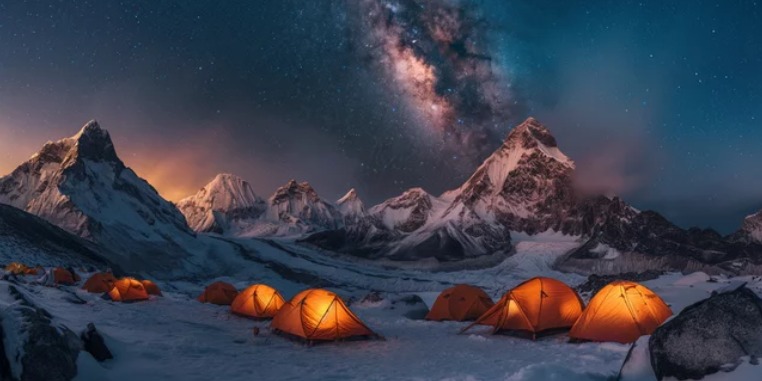
Apr 08, 2024
Island Peak Climbing in May
- What Time of Year is Best to Climb Island Peak?
- Is May a Good Time to Visit Island Peak?
- How Difficult is Island Peak to Climb?
- How Long Does It Take to Climb Island Peak?
- Weather and Temperature During Everest Base Camp with Island Peak Climbing in May
- Why Everest Base Camp with Island Peak in May
- Scenic Lukla Flight
- Pleasant Weather Conditions
- Vibrant Trekking Trails and Terrains
- Breathtaking Clear Mountain Views
- Bright Sunny Days
- Dry Trekking Trail
- Lower Chances of Flight Delays and Cancellations
- Final Say
- Island Peak Climbing Packages
Climbing Island Peak in May offers a compelling adventure amidst the towering peaks of the Everest region in Nepal. Standing at 6,189 meters (20,305 feet), Island Peak, also known as Imja Tse, is a popular choice for climbers seeking both a challenging ascent and breathtaking Himalayan panoramas.
May marks the tail end of the spring climbing season in Nepal, making it an excellent time to tackle Island Peak. The weather during this month is generally stable, with clear skies and mild temperatures. This provides ideal conditions for climbing, offering good visibility of the surrounding snow-capped peaks, including the iconic Mount Everest.
The journey to Island Peak typically begins with a scenic flight from Kathmandu to Lukla, followed by a trek through the picturesque Sherpa villages of the Khumbu region. Trekkers pass through dense rhododendron forests, traverse high suspension bridges over roaring rivers, and soak in the rich cultural heritage of the region.
As climbers approach Island Peak Base Camp, located near Chhukung village, they undergo acclimatization and receive training from experienced guides. This includes practicing essential mountaineering techniques such as ice axe handling, rope skills, and safety protocols necessary for navigating the glacier-covered terrain ahead.
The ascent to Island Peak’s summit usually involves establishing a High Camp for the final push. Climbers wake before dawn to begin the climb, navigating steep sections and crevasses as they make their way towards the summit. The effort is rewarded with panoramic views that stretch across the Everest region, with peaks like Lhotse and Nuptse dominating the horizon.
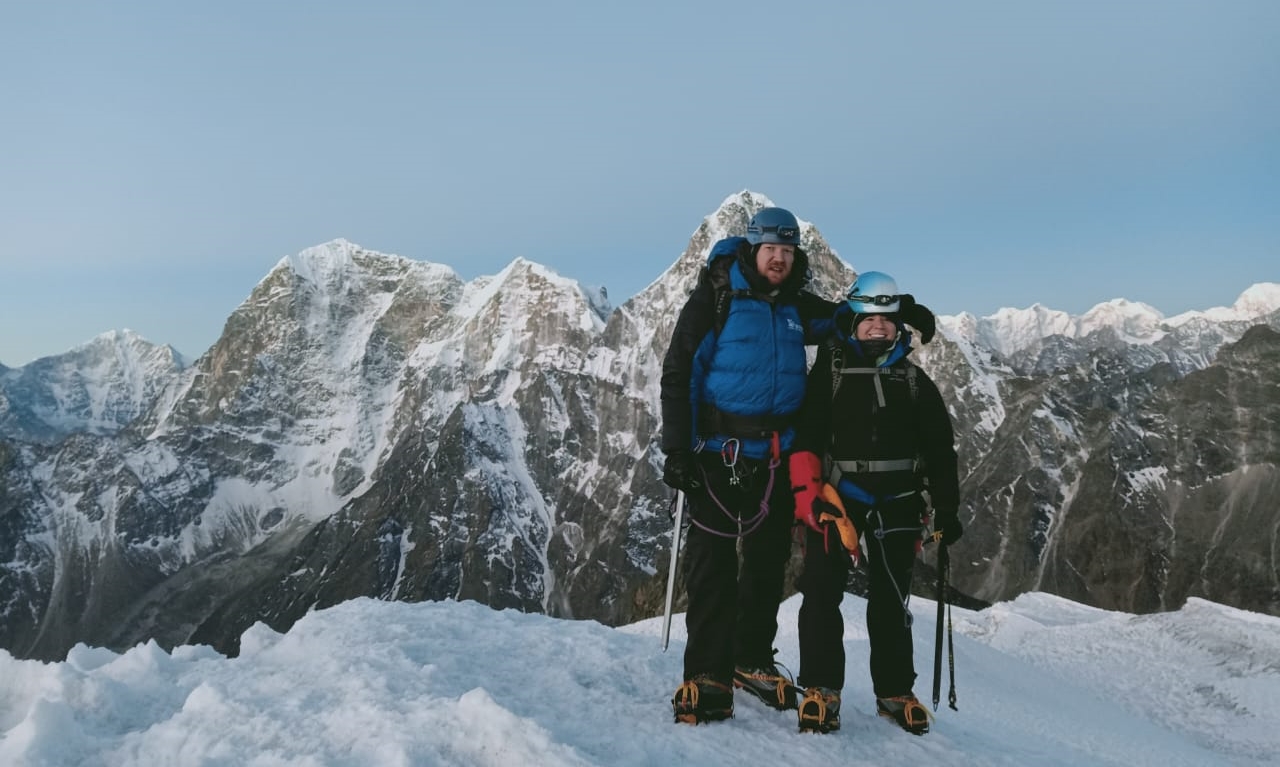
LOBUCHE PEAK CLIMBING
Lobuche East (6,119m/20,075ft), set in Nepal's stunning Khumbu on the Nepalese side of Everest.The best time to go trekking in Nepal is in Autumn (September-November) and in...
Summiting Island Peak in May allows climbers to witness the sunrise casting its golden glow upon the Himalayan giants, creating a surreal and unforgettable experience. After celebrating their achievement, climbers descend carefully back to Base Camp and retrace their steps through the scenic trails of the Khumbu region.
Beyond the physical and technical challenges, climbing Island Peak in May is also a cultural journey. Trekkers encounter Sherpa hospitality, visit ancient monasteries adorned with prayer flags, and gain insight into the traditions and daily lives of the local communities.
In conclusion, Island Peak in May presents a perfect blend of adventure, natural beauty, and cultural immersion. Whether you are an experienced mountaineer or embarking on your first Himalayan climbing expedition, May offers optimal conditions to conquer this iconic peak and create memories that will last a lifetime.
What Time of Year is Best to Climb Island Peak?
The best times to climb Island Peak are during the pre-monsoon (spring) season from April to May and the post-monsoon (autumn) season from late September to early November. These periods offer stable weather conditions with clear skies, minimal precipitation, and moderate temperatures, making climbing safer and more enjoyable. Spring months like April and May are particularly favored for climbing due to blooming rhododendrons, vibrant landscapes, and excellent visibility of the Himalayan peaks.
Is May a Good Time to Visit Island Peak?
Yes, May is considered an excellent time to visit and climb Island Peak. It falls within the spring climbing season in Nepal when the weather is generally stable and clear. In May, climbers can expect mild temperatures during the day and relatively warmer nights compared to earlier spring months. The trails are adorned with colorful flowers, enhancing the scenic beauty of the Everest region. Clear skies offer spectacular views of Mount Everest and neighboring peaks from Island Peak’s summit. With proper preparation and acclimatization, May provides optimal conditions for a successful and memorable climbing experience.
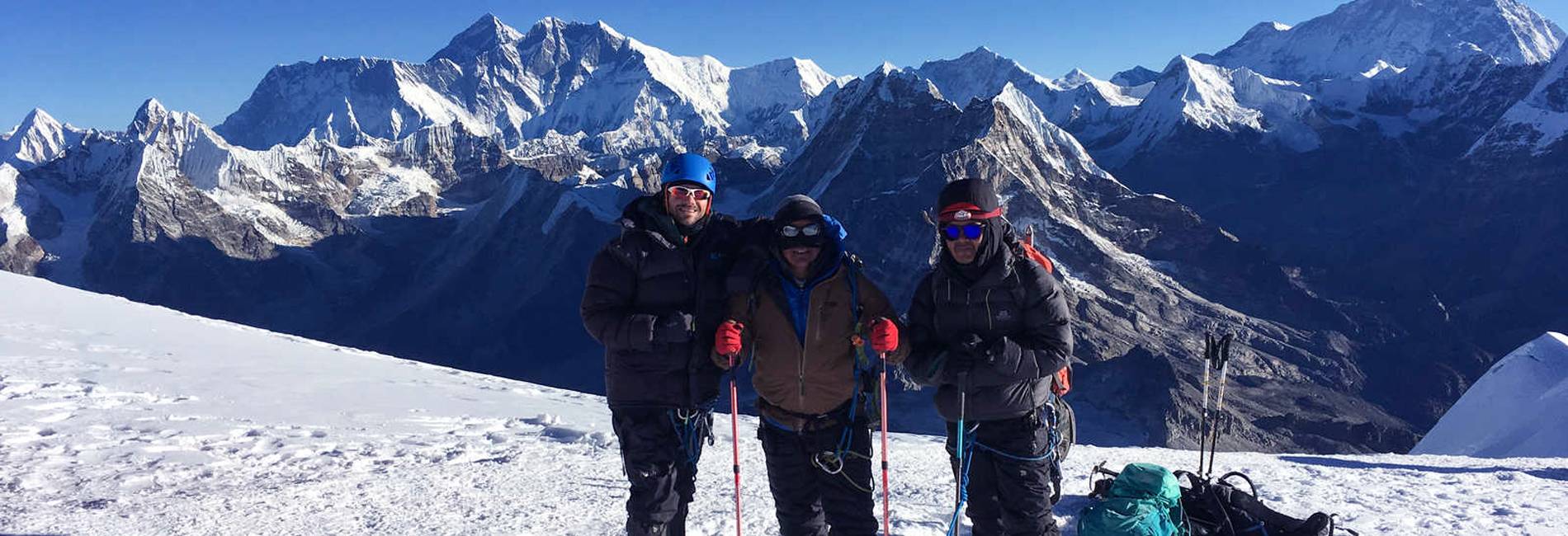
MERA PEAK CLIMBING
Mera Peak Climbing is an exhilarating adventure in Nepal that gives you an opportunity to reach the summit of Mera Peak at more than 6400m above sea level. Actually, it is the highest climbing (w...
How Difficult is Island Peak to Climb?
Island Peak is considered a moderately difficult climb. It requires basic mountaineering skills such as using crampons, ice axes, and ropes to navigate through steep sections and glaciated terrain. The ascent involves technical climbing, including fixed ropes and ladder crossings, especially near the summit. Climbers need to be physically fit, mentally prepared for high altitude, and capable of enduring long hours of trekking and climbing. While challenging, Island Peak is a popular choice for climbers aiming to advance from trekking to higher altitude mountaineering in the Everest region.
How Long Does It Take to Climb Island Peak?
The duration to climb Island Peak typically ranges from 16 to 20 days, depending on the chosen itinerary and climber’s pace. The expedition includes trekking from Lukla to Base Camp via Namche Bazaar and Dingboche, which takes about 7 to 9 days. Acclimatization days are crucial to prevent altitude sickness. From Base Camp, climbers spend additional days for training, preparation, and adjusting to the altitude before attempting the summit. The climb from Base Camp to the summit and back usually takes 1 to 2 days, followed by a descent to Lukla. Overall, the expedition allows for gradual acclimatization and a safe ascent to Island Peak’s summit amidst the stunning landscapes of the Everest region.
Weather and Temperature During Everest Base Camp with Island Peak Climbing in May
May is an ideal time for Everest Base Camp and Island Peak climbing due to favorable weather conditions. During this month, temperatures at lower altitudes, such as Lukla and Namche Bazaar, range from 10 to 20°C (50 to 68°F) during the day, making trekking comfortable. As climbers ascend towards higher altitudes, temperatures gradually decrease, with nighttime temperatures often dipping below freezing. However, May typically experiences clear skies and minimal precipitation, ensuring good visibility and safe climbing conditions. Proper layering and gear are essential to stay warm and comfortable throughout the expedition.
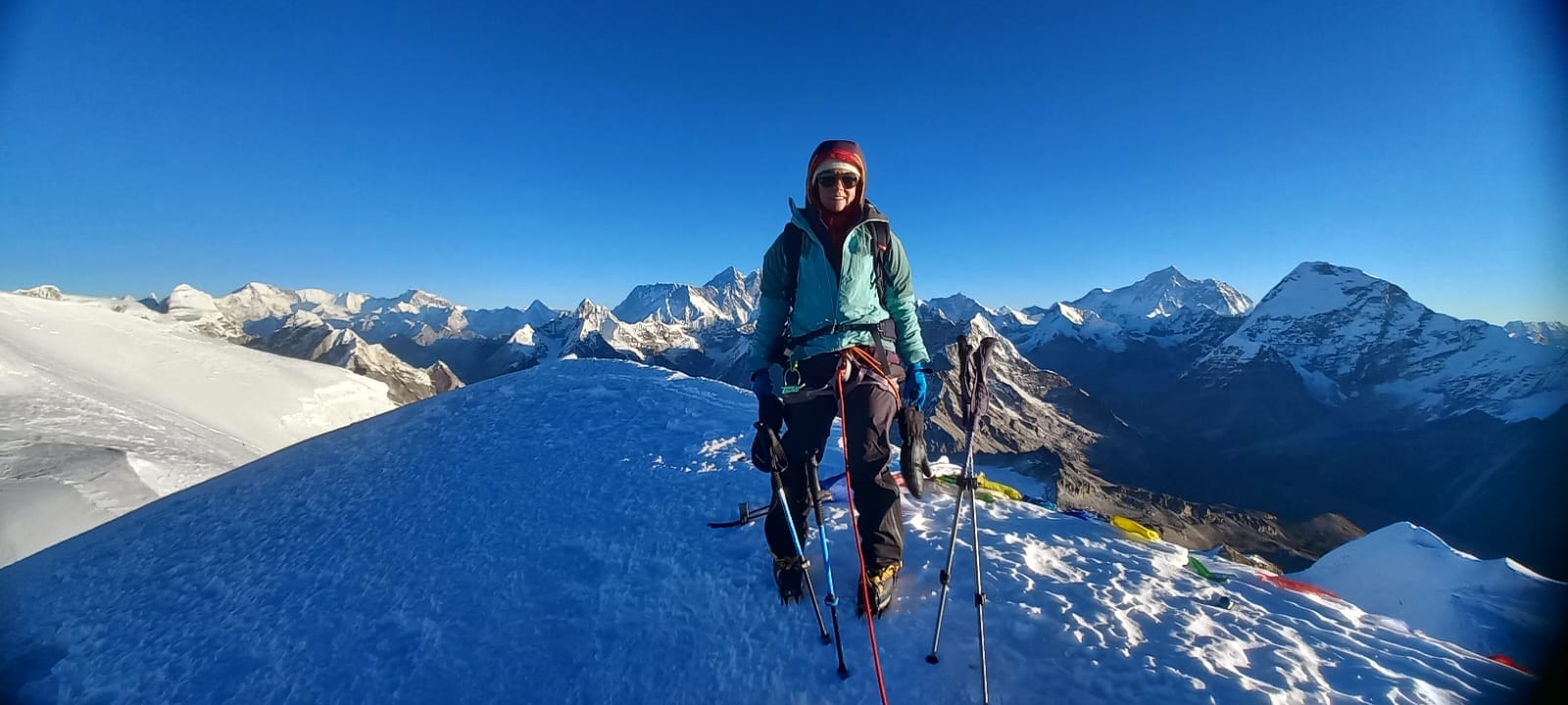
Three Peak Expedition
Embark on an unforgettable journey to the heart of the Himalayas as you conquer three majestic peaks: Mera Peak, Island Peak, and Lobuche Peak. This ultimate adventure combines technical climbing, bre...
Why Everest Base Camp with Island Peak in May
Choosing to trek to Everest Base Camp and climb Island Peak in May offers several advantages. The weather in May is generally stable and mild, with clear skies providing excellent visibility of the Himalayan peaks. The trekking trails are adorned with blooming rhododendrons and other colorful flowers, creating a vibrant and picturesque journey through the Sagarmatha National Park. Climbers also benefit from optimal climbing conditions, with warmer daytime temperatures and manageable nighttime cold at higher altitudes. May falls within the peak trekking season in Nepal, offering a chance to experience the local culture, meet fellow trekkers, and enjoy the bustling atmosphere of teahouses along the trail.
Scenic Lukla Flight
The flight from Kathmandu to Lukla is an exhilarating start to the Everest Base Camp and Island Peak climbing adventure. The short but scenic flight takes about 30 to 40 minutes, offering stunning aerial views of the Himalayas, including peaks like Everest, Lhotse, and Makalu. The small airstrip at Lukla, nestled among the mountains, adds to the excitement of landing in one of the world's most renowned trekking destinations. The flight not only saves days of arduous trekking but also provides a memorable introduction to the rugged beauty and grandeur of the Everest region, setting the tone for an unforgettable trekking and climbing experience.
Pleasant Weather Conditions
During May, the Everest Base Camp and Island Peak climbing expedition benefits from pleasant weather conditions. Daytime temperatures are generally mild and comfortable for trekking, ranging from 10 to 20°C (50 to 68°F) at lower altitudes. The nights and early mornings are cooler, with temperatures often dropping below freezing as climbers ascend higher. May is characterized by clear skies and minimal rainfall, offering excellent visibility of the surrounding mountain peaks. These favorable weather conditions enhance safety and enjoyment, allowing climbers to appreciate the stunning landscapes and achieve their climbing goals without the hindrance of adverse weather.
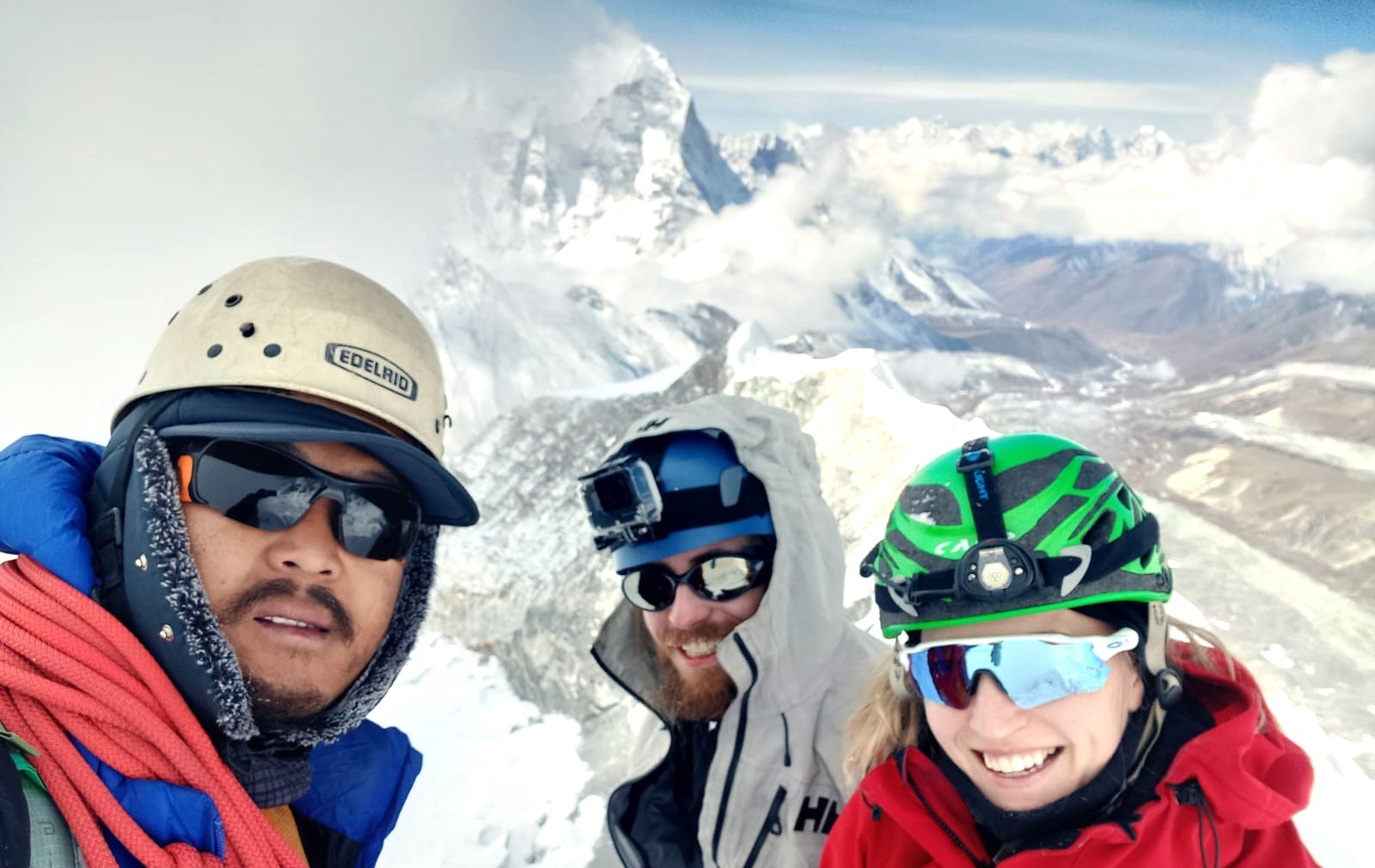
ISLAND PEAK EXPEDITION 15 DAYS
Island Peak, also known as Imja Tse, is a popular peak located in the Khumbu region of Nepal. This peak is a part of the Himalayas and stands tall at a height of 6,189 meters above sea level. Island P...
Vibrant Trekking Trails and Terrains
Trekking to Everest Base Camp and Island Peak in May promises vibrant trails and varied terrains that showcase the natural beauty of the Himalayas. The routes pass through lush rhododendron forests, tranquil Sherpa villages, and high alpine valleys dotted with prayer flags. The vibrant hues of blooming flowers, including rhododendrons in shades of red, pink, and white, add a splash of color to the trekking experience. As climbers progress towards Island Peak, the terrain transitions to rugged glaciers and steep slopes, offering both scenic views and thrilling challenges. The diverse landscapes and ever-changing scenery make each day of the trek a unique and enriching experience amidst the awe-inspiring Himalayan wilderness.
Breathtaking Clear Mountain Views
In May, climbers are treated to breathtaking clear mountain views throughout the Everest Base Camp and Island Peak climbing expedition. The clear skies and minimal cloud cover provide uninterrupted panoramas of iconic peaks such as Everest, Lhotse, Nuptse, and Ama Dablam. From viewpoints along the trekking route to the summit of Island Peak itself, climbers can witness the majesty of these snow-capped giants bathed in sunlight. Sunrise and sunset cast a golden glow over the mountains, creating unforgettable moments for trekkers and climbers alike. The pristine beauty and grandeur of the Himalayan landscape unfold in all its glory, inspiring awe and admiration with every step of the journey.
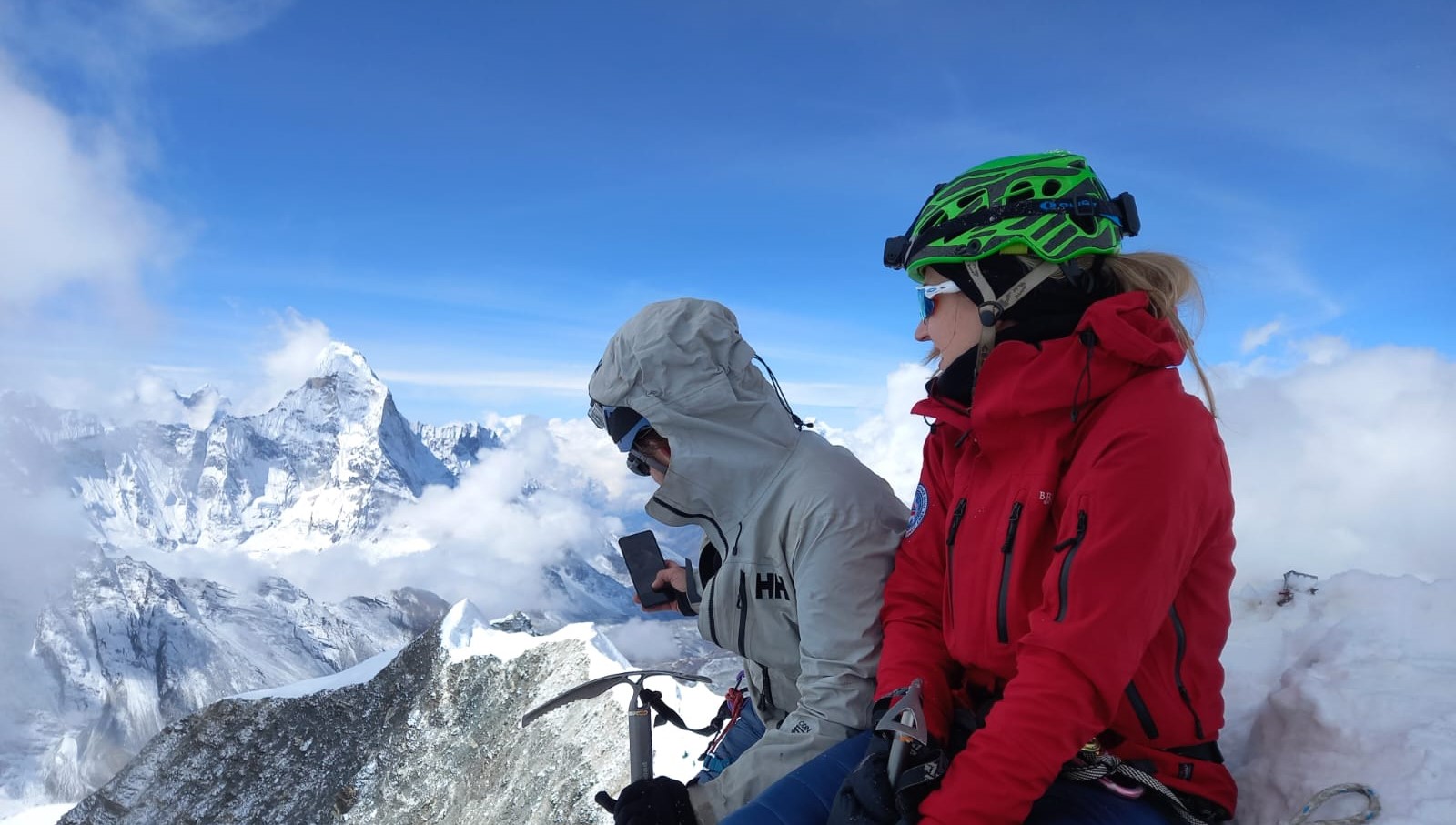
ISLAND PEAK EXPEDITION 14 DAYS
Island Peak Expedition is a 14-day adventure tour that takes you to the heart of the Himalayas, where you can witness the beauty of the mountains, valleys, and glaciers. Island Peak, also known as Imj...
Bright Sunny Days
During the trekking season in Nepal, particularly in May, bright sunny days are a common occurrence. These days offer clear skies and ample sunshine, creating ideal conditions for trekking and climbing activities. Bright sunny days not only enhance visibility of the surrounding landscapes but also contribute to a pleasant trekking experience. Climbers can enjoy stunning views of the Himalayan peaks, including Mount Everest, Lhotse, and Ama Dablam, bathed in sunlight. The warmth of the sun during the day provides a welcome respite from the cooler temperatures at higher altitudes, allowing climbers to comfortably explore the trekking trails and appreciate the natural beauty of the Everest region.
Dry Trekking Trail
In May, the trekking trails to Everest Base Camp and Island Peak are relatively dry and stable. The pre-monsoon season in Nepal brings lower chances of rainfall and snowfall, resulting in well-maintained paths and minimal mud. Dry trekking trails offer safer and more comfortable conditions for climbers, facilitating easier navigation and reducing the risk of slips or falls. The absence of wet conditions also allows climbers to focus on enjoying the trekking experience and immersing themselves in the breathtaking landscapes without the hindrance of muddy or slippery terrain.
Lower Chances of Flight Delays and Cancellations
May typically experiences lower chances of flight delays and cancellations for flights from Kathmandu to Lukla, the gateway to the Everest region. The stable weather conditions during this month reduce the likelihood of adverse weather affecting flights. Clear skies and minimal precipitation contribute to smoother flight operations, allowing climbers to arrive in Lukla on schedule and commence their trekking and climbing adventures without interruptions. Lower incidences of flight delays and cancellations in May enhance the overall logistics of the expedition, ensuring a more efficient and enjoyable experience for climbers as they embark on their journey to Everest Base Camp and Island Peak.
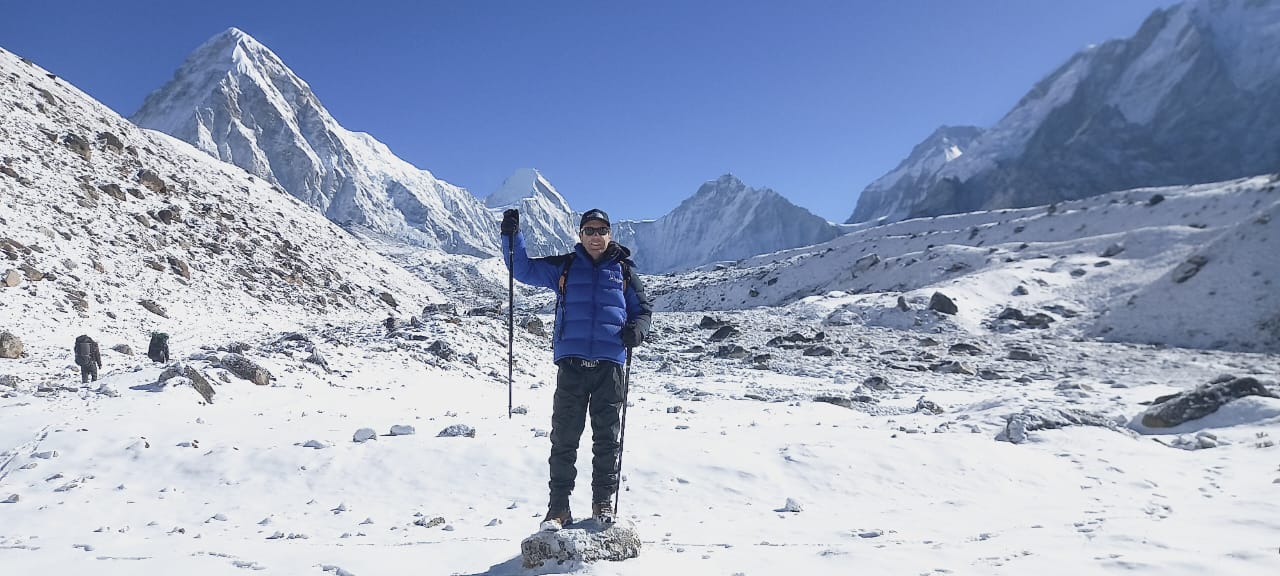
ISLAND AND LOBUCHE PEAK CLIMBING
Lobuche and Island Peak combo climbing expedition is a thrilling adventure that offers a unique opportunity to conquer two popular peaks in the Everest region of Nepal. Lobuche Peak (6,119m) and Islan...
Final Say
Climbing Everest Base Camp and Island Peak in May offers an exceptional opportunity to experience the best of Nepal's trekking and mountaineering adventures. With bright sunny days providing clear views of majestic Himalayan peaks, dry trekking trails ensuring safer and more comfortable conditions, and lower chances of flight delays and cancellations facilitating smoother logistics, May stands out as an optimal month for climbers seeking an unforgettable Himalayan expedition. Whether you are drawn to the awe-inspiring landscapes, the cultural richness of Sherpa villages, or the challenge of summiting Island Peak, May offers favorable conditions to fulfill your mountaineering aspirations amidst the splendor of the world's highest mountains.
Island Peak Climbing Packages
Island Peak Summit Return By Helicopter
Island Peak Expedition 14 Days
Island Peak Expedition 15 Days
Everest Three Pass with Island Peak Climbing

ISLAND PEAK CLIMBING
Sherpa Expedition & Trekking (Est.1977) are pleased to announce FOR ADVENTURERS the most awesome, exhilarating & unforgettable climbing and treks on offer anywhere today!...
Any Questions? Let Us Know.
Recent Posts
17th June, 2025


















